- March 3, 2023
- Posted by: CENTERSPREAD
- Category: Uncategorized

If you’re tired of your website lurking in the dark depths of Google’s search results, it’s time to get serious about keyword research. Let’s face it, without the right keywords, your content is basically invisible to potential customers.
But fear not, because we’ve got you covered with this ultimate guide to keyword research. Get ready to boost your SEO game and finally claim your spot at the top of the search results!
What are keywords?
Keywords are words & phrases that serve as the linchpin between the search queries & the content that you’re providing to answer that query.
If you’re running a website or creating content, you need to ensure that your page’s keywords align with what your audience is searching for. Why, you ask?
Well, it’s simple – this boosts your chances of appearing higher up on the search engine results page (SERP), making it easier for your target audience to find your content.
What is the importance of keyword research?

Keyword research is a process of refinement that helps you identify the most effective keywords to target and offers valuable insight into the search queries that your target audience is actually typing into Google.
It helps you shape not only your content strategy but also your larger marketing strategy. So if you want to stay ahead of the game, you better do your research and get on top of those keywords.
Different Types of Keywords
The first step in keyword research is to understand the different types of keywords that exist. Let me introduce you to the main categories of keywords that you need to know.
1- Focus Keywords/Seed Keywords/Primary Keywords
Short-tail keywords, or head keywords, are made up of three words or less and have high search volume, but also high competition.
Searchers often use short-tail keywords when they’re at the beginning of their research process, making it difficult to pinpoint their exact intent. As a result, short-tail keywords can be challenging to convert because they’re often ambiguous. For example, a search for “cake” could mean different things, such as finding out how to make a cake or the ingredients needed to make it or the nearest place to get a cake.
2- Long-tail Keywords
Long-tail keywords are more specific and typically contain more than three words. Although they have lower search volume than short-tail keywords, they’re less competitive.
The advantage of long-tail keywords is that they provide clear search intent, making it easier to target the right audience. For example, a search for “ingredients for a chocolate cake” indicates a user’s intent to get information about making a cake.
3- Geo-targeting Keywords
Geo-targeting keywords can help you attract the most relevant customers, especially for smaller local businesses looking to boost their local SEO. You can target a specific neighborhood, city, state, or even country by simply using the area your business serves as your geo-targeting keyword.
While you might already have your address displayed on your website, inserting it into your content can make a big difference. Acquiring geo-targeting keywords is easy and can be achieved by simply using your business’s service area.
Using our earlier example of cake, geo-targeted keywords would be “chocolate cake near me” “best cheesecake in East Manhattan”.
4- LSI Keywords
LSI (Latent Semantic Indexing) Keywords are related keywords that share a theme with your main keyword. For instance, if your main keyword is “cake,” then your LSI keywords may include “cake recipe”, “calories in a cake,” or “make a cake.”
LSI keywords can help you create content on a broad topic and target smaller branches based on one root keyword. This means your content will show up for various related keywords that users search for.
To find LSI keywords, you can check the suggested search section on the search result page or use tools like LSIGraph to get a list of LSI keywords with search volume and competition data.
5- Intent-Based Keywords
Before we move on, let’s understand what user intent is.
User intent refers to the underlying purpose or motivation behind a user’s search query. It’s about understanding what the user is trying to accomplish or the problem they are trying to solve by conducting a search.
There are 4 major types of keywords differentiated on the basis of “User Intent”.
1- Informational keywords are used by searchers who are seeking answers to specific questions or looking for general information.
2- Navigational keywords are used by users who are looking to find a specific website or page.
3- Transactional keywords are used by searchers who have an intent to complete a specific action, such as making a purchase or signing up for a service.
4- Commercial keywords are used by users who are interested in researching brands or services.
Keyword research tools
A keyword research tool helps content creators and marketers find the most relevant and valuable keywords to target.
To use a keyword research tool, you need to input a seed keyword or phrase related to your business; it will then generate a list of related keywords and phrases, along with data on their search volume, competition level, and potential value for driving traffic or conversions.
Some tools may also provide additional features like keyword difficulty analysis, backlinks, trend tracking, and competitor research to help users optimize their content and targeting strategies.
There are many keyword research tools available. Check out a brief overview of some of our favorites:
1- SEMRush
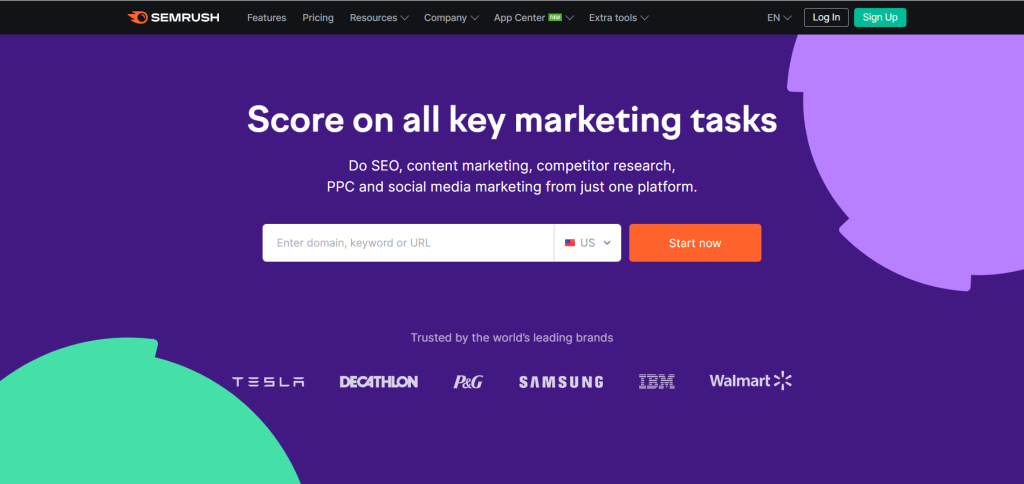
SEMrush is the ultimate SEO tool suite for keyword research and improving your SEO rankings.
- With the Keyword Overview tool, you simply enter your keyword and get a comprehensive report, including monthly search volume, trend data, and similar keywords. You can also view organic search results and check out Google Ads using that keyword.
- By using the Domain Overview, you can even see your competitor’s organic search terms, keyword data, and organic traffic metrics.
- With the Organic Research tab, you get relevant keyword information, competitor search rankings, and traffic value data.
Rated by the world’s top marketers as the #1 keyword research tool, SEMRush’s full suite of tools can help with content marketing, digital marketing, social media, and more.
2- Ubersuggest
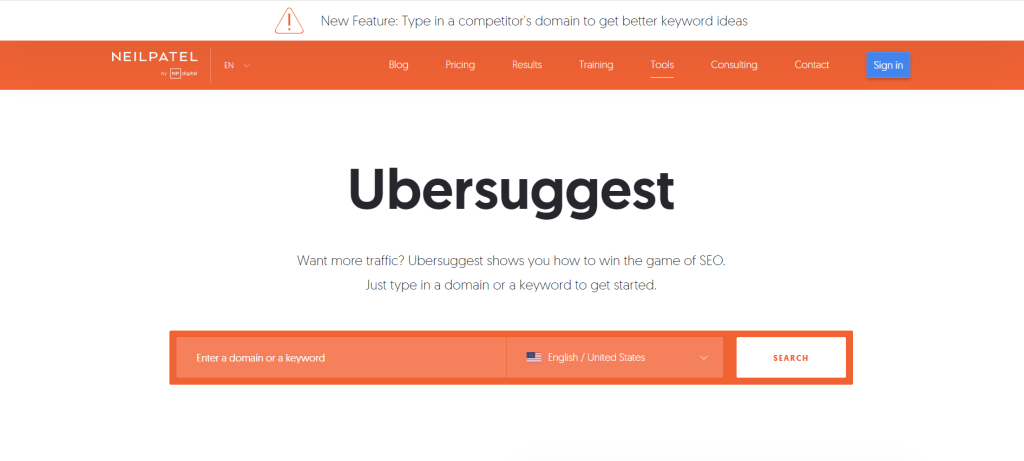
Ubersuggest, the free tool from Neil Patel, provides valuable data like search volume, keyword suggestions, and keyword difficulty. It also shows related keywords and a table of the top 100 Google results for that keyword, along with estimated visits, backlinks, domain score, and social shares.
The Content Ideas feature displays related content with estimated monthly visits, backlinks, and social shares on Facebook and Pinterest.
Sign in with your Google account, and get access to more keyword suggestions, daily rank tracking, and personalized SEO recommendations. Ubersuggest’s Chrome extension can also help streamline your workflow.
3- AHrefs
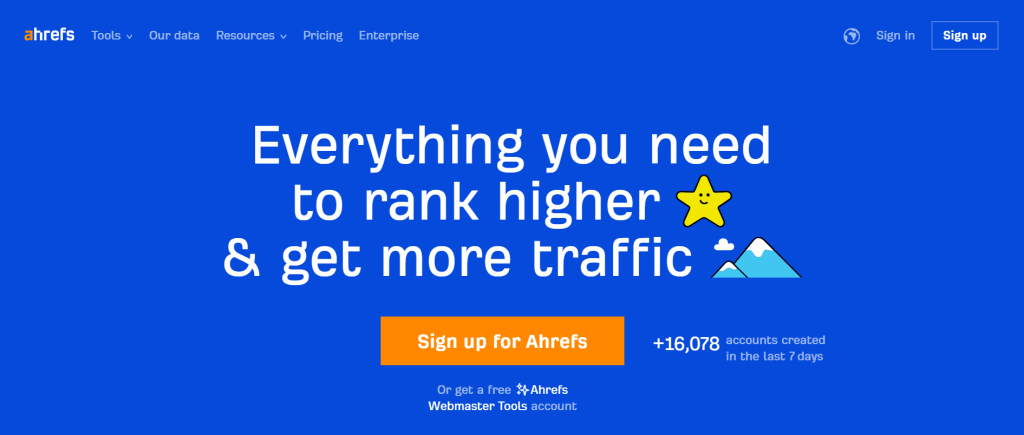
Ahrefs is a popular keyword research tool that offers similar features to SEMrush. You can generate keyword ideas using their Keyword Explorer. It does not limit you to one search engine but allows you to find and analyze keywords on YouTube, Amazon, Yandex, and Bing. You can also use Ahrefs to discover keywords your competitors rank for and then use it to create new content targeting those keywords.
Ahrefs’ backlink checker is great because of its filtering & sorting features. Ahrefs have a massive link index since their crawler is 2nd most active after Google.
4- Google Keyword Planner
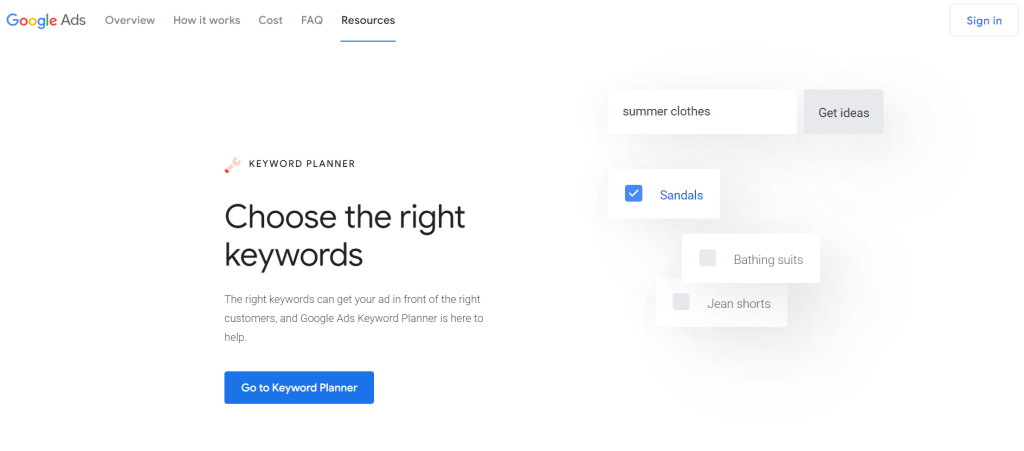
While Google’s Keyword Planner is primarily designed for advertisers running ads on Google, it’s still a helpful tool for SEO, and it’s free to use. To access it, you’ll need a Google Ads account, but you don’t need to run an active campaign or pay for anything.
Once you’ve gained access, you can enter any keyword and view data for approximate monthly searches, along with a list of related keyword ideas that you can scroll through or download.
5- Serpstat
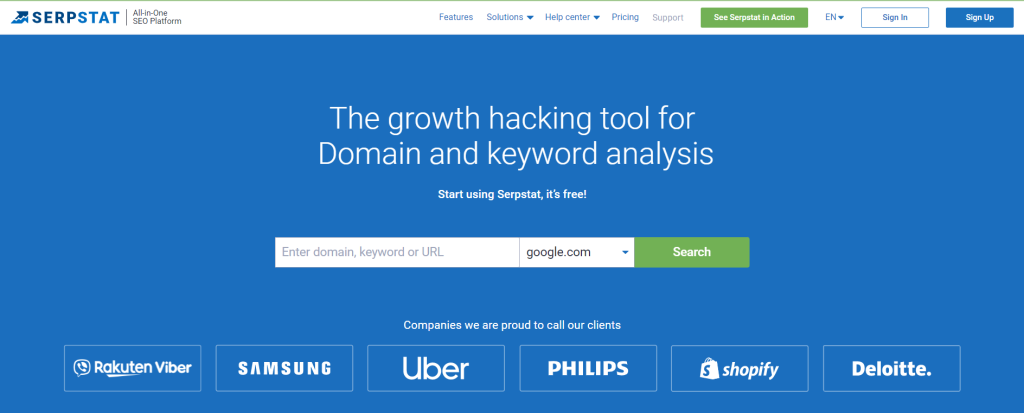
Serpstat is a powerful SEO tool that you can use to enhance the online visibility of your business. With its diverse range of features, including keyword research, site audit, backlink analysis, competitor research, and rank tracking.
Serpstat provides a wealth of data-driven insights to help you optimize your SEO strategy. By leveraging its advanced features and integrations with other tools like Google Analytics, Serpstat empowers you to identify new opportunities and track your website’s performance, all in one place.
Whether you want to improve your search rankings or gain a competitive edge, Serpstat has everything you need to succeed.
How to conduct keyword research?

To develop a solid keyword strategy and attract the right audience, follow these essential steps:
- Identify broad topics
- Create a list of related phrases for each topic
- Find related search terms
- Analyze keyword strength
- Consider SERP features
- Use a mix of terms
Now let’s expand on each step so you can understand better.
1- Identify broad topics
To start with, build a spreadsheet with a concise list of categories or “buckets” that describe the keywords you intend to target. This can be related to product categories or any subject matter that would pique the interest of your desired audience. If you frequently blog, you might have some regular topics to include. Limit your list to 5-10 topics to keep it straightforward. Consider yourself a buyer searching for a product or service to help guide your choices.
Here are some potential keyword categories for a small business selling handmade granola and cookies:
- Granola flavors
- Cookie types
- Organic ingredients
- Healthy Snacks
- Health benefits of granola and cookies
- Recipes using granola or cookies
2. Create a list of related phrases for each topic
For each topic, brainstorm a list of phrases that your target audience might use when searching for information; related to the general categories you created in the previous step. You can use your Google Analytics account to examine your organic search traffic data to identify the keywords customers are already using to find your website. This brainstorming exercise will not produce your final list of keywords. It is a way to generate data points for more focused and productive research.
For instance, in the case of a small business selling handmade granola and cookies, you might list keywords under the “Healthy Snacks” category as:
- Gluten-free granola bars
- Organic cookies for kids
- Vegan energy bites
- Nut-free granola clusters
- Paleo snack ideas
Compile a list of specific keywords under each general category and add them to your spreadsheet. Don’t hesitate to ask your colleagues or employees, especially those who interact with customers, for additional ideas.
3- Find related search terms
There are plenty of creative ways to expand your keyword lists.
- Search your keyword on Google. You will discover a few related search phrases, highlighted in bold when you scroll down to the bottom of the page.
- For a more in-depth analysis, click on one of the related searches and explore, and you will find more suggestions at the bottom of the second page.
- AnswerThePublic is a keyword research tool that generates a visualization of search query data based on the user’s input. It provides insights into the questions and phrases that people are searching for online. You can use it to add on to your keyword list
- Build on your keyword list using the keyword research tools we reviewed earlier.
4. Analyze keyword strength
To analyze the strength of a keyword, you can use various metrics such as search volume, keyword difficulty, and relevance.
Search volume refers to the number of times a keyword is searched in a given period, usually a month. A higher search volume indicates greater potential traffic for that keyword.
Keyword difficulty, on the other hand, refers to the level of competition for a particular keyword. The more websites that are trying to rank for a keyword, the higher the difficulty score will be.
Finally, relevance is an important factor in determining keyword strength. It’s important to choose keywords that are relevant to your business and website content.
By analyzing these metrics, you can identify high-potential keywords to target in your SEO strategy.
5. Consider SERP features
SERP features are essential to consider when optimizing your content for search engines. Google will highlight several snippets, including image packs, paragraph snippets, list snippets, and video snippets.
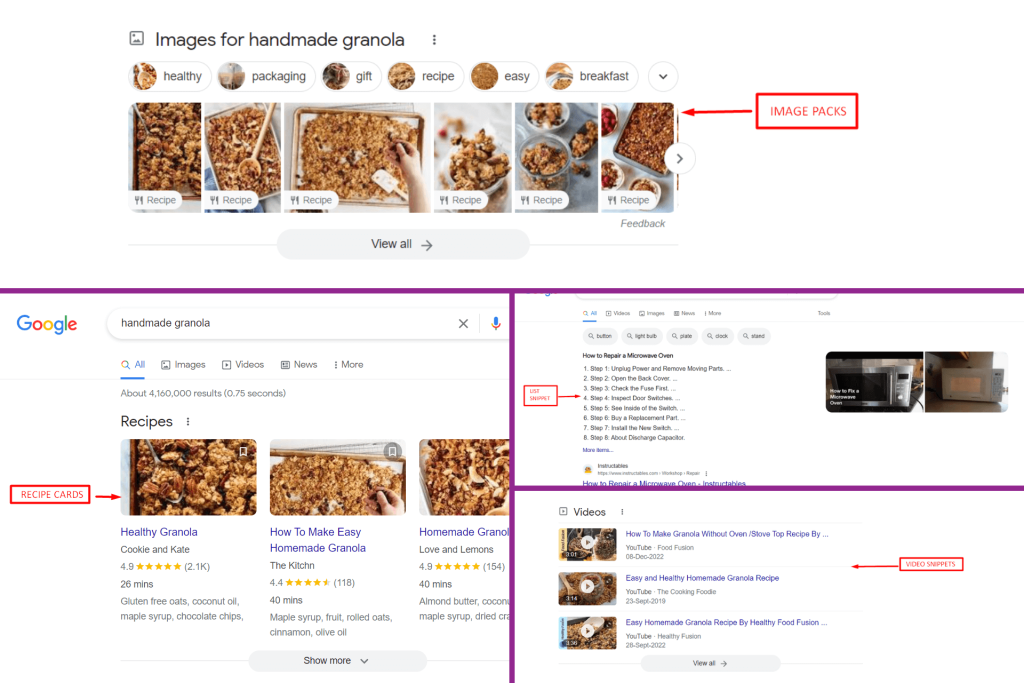
- Image packs show a horizontal row of images, therefore including relevant images can help you win placement in them.
- Featured snippets provide quick answers to common search queries and require succinct, concise answers that address the searcher’s intent.
- List snippets are useful for “How To” searches and require direct, clear instructions and formatting.
- Video snippets, which appear at the top of the search results as short videos, require relevant tagging of keywords on both YouTube and your website
6. Verify Search Intent
In the world of Google search, every query from a consumer represents a question that demands an answer.
As a business owner, it’s crucial to ensure that you understand your customers’ intent. One way to do this is by typing your targeted keywords into the search engine to see what pages are already ranking for that phrase and what they offer. This allows you to tailor your content to meet the searcher’s needs and avoid creating content that doesn’t match their intent.
Understanding buyer intent for each keyword can be noted down in your spreadsheet or incorporated into your content creation process.
Finally, ensure that you use a mix of different types of keywords, including long-tail phrases and broader, more competitive terms. This will help to diversify your content and improve your chances of ranking for a variety of search queries.
Conclusion
In conclusion, keywords are essential for ensuring your content is visible and discoverable online.
By conducting thorough keyword research, you can identify the words and phrases that your target audience is searching for and optimize your content accordingly. This not only increases the chances of your content being found but also improves its relevance and usefulness to your audience.
The five keyword research tools we discussed can provide valuable insights and save time in the research process.
By following the step-by-step process outlined in this post, you can create a comprehensive list of targeted keyword.
Remember, keyword research is an ongoing process. Therefore, continue to monitor and adjust your keywords to stay ahead of the competition and meet the evolving needs of your audience.
Feel free to check out our SEO case studies to learn more!